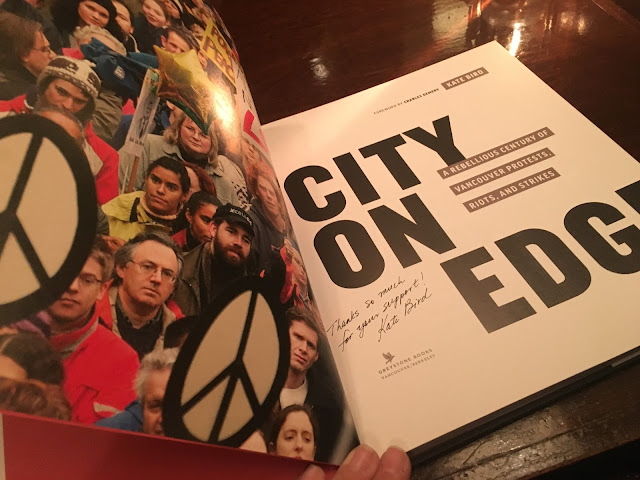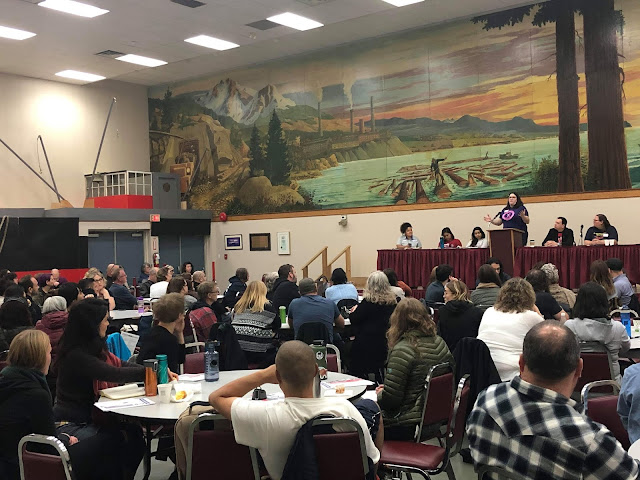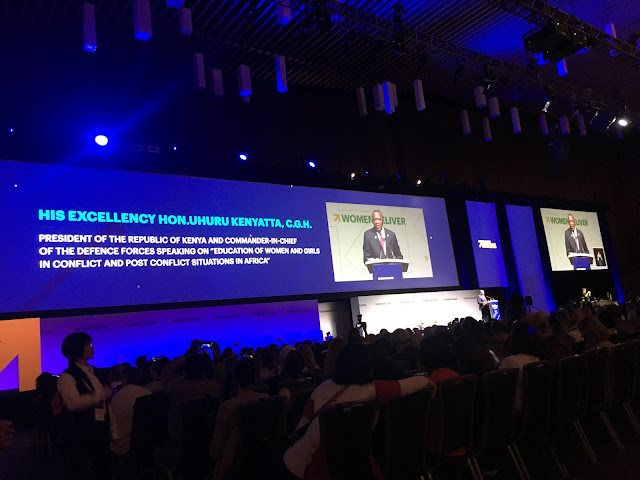When Labour Walks the Line : The Workers' Side of the Story
Last night I attended a panel discussion on significant job action in Vancouver that included the 2001 Transit strike, the 2004 HEU strike, the 2007 strike in the City of Vancouver and the 2014 teachers' strike.
The members of the panel were:
- Moderator: Irene Lanzinger, President of BC Federation of Labour
- Joe Elworthy, UNIFOR 2200
- Donisa Bernardo, Hospital Employees Union (Financial Secretary)
- Aliza Nevarie, President, CUPE 391 (Vancouver Public Library Workers)
- Glen Hansman, President, BC Teachers' Federation
Irene introduced the session with the lyric "without our brains and muscle, not a single wheel could turn" from our anthem, Solidarity Forever. Workers are the engines of our economies and the pillars of our communities and that it is important to ensure a class analysis in everything we do. When people think of unions they often think of strikes- strikes are a tool (they're not perfect) to engage, communicate, protest and press our employers for fair compensation and working conditions. Irene always talks with such passion about the 2005 illegal BCTF strike (14 days) and the satisfaction of winning a fight everyone said they would lose.
Joe Elworthy, UNIFOR 2200 - 2001 Transit Strike
The 2001 Transit strike was the 2nd largest transit strike in Vancouver (the first being in 1984) and it lasted 4 months. The was a situation that was tough on the public, drivers and workers and it was all because of the perfect storm of circumstances. The union was fractured - it had just gone through raiding, where CAW won the certification (but only by a slim margin). A key piece of context was that the sector was transitioning from BC Transit to Translink. They didn't really know who the employer really was - it was all over the place. The point of contention for the workers wasn't wages and benefits but over contracting out and two tier contracts. Taxis were taking their runs and they went a star as flying Buzz Hargrove in to try and leverage that kind of power at the bargaining table. When Vince Ready came up with a deal, the union was happy but the employers rejected it. At one point the employer walked out on negotiations and the union and the bus riders' union held a mock Translink meeting out of frustration which led to a few laughs. When the government went from NDP to Liberal, they were legislated back to work and imposed the Ready settlement. Overall the public support was amazing and the union pulled together like they never had before.
Donisa Bernardo, Hospital Employees Union, 2004 HEU Strike
Donisa regaled us with the epic tale of the events on and surrounding the 2004 HEU strike. The HEU has 44,000 members, representing 100s of occupations, 85% women and more than 50% of their members in Vancouver are racialized. The strike lasted 8 days (which doesn't sound long but when you're in healthcare and bound by essential services orders, it's considered a long time). For years they fought against gender based pay discrimination and when the Campbell Liberals came to power in 2001, they opposed the HEU's pay equity gains. The condescension of Minister Colin Hansen was on front street - where he called the workers in laundry, dietary and housekeeping "overpaid."
 As a citizen of BC, I know how much those services has deteriorated since being contracted out...but we'll get there.
As a citizen of BC, I know how much those services has deteriorated since being contracted out...but we'll get there.
January 2002 marked the largest mass firing of women in post-war Canadian history. Wages were also cut in half, pensions eliminated and benefits decimated. This is also where we saw increased privatization of nursing homes.
Donisa shared appreciation of solidarity across the labour movement, including a resolution passed at the CUPE BC Convention to mobilize and support the HEU. When they finally went on strike, she said the visibility of all the workers and supporters snaking down Oak Street, Burrard and others was powerful. On the 4th day of the strike the union saw back to work legislation and the introduction of Bill 37 (which included 15% wage rollbacks). On the 6th day 20k CUPE workers walked off the job and the talks of a general strike were mounting. HEU was found in contempt of court and faced $500k/day fines. They cut a deal and have been dealing with the aftermath of this ugly battle ever since.
It hasn't been easy, dealing with the fine, contracting out, contract flipping and decades long raiding by the BC Nurses. They went on strike in the face of huge injustice and sparked a backlash against the government with the public on their side. The HEU was determined to fight on front for their members, their families and their communities.
HEU workers are some of the most resilient, passionate activists I've met in the labour movement and I'm always in awe of how positive and determined they are no matter what the circumstances.
Aliza Nevarie, President CUPE 391 (Vancouver Public Library Workers - VPL)
Donisa Bernardo, Hospital Employees Union, 2004 HEU Strike
Donisa regaled us with the epic tale of the events on and surrounding the 2004 HEU strike. The HEU has 44,000 members, representing 100s of occupations, 85% women and more than 50% of their members in Vancouver are racialized. The strike lasted 8 days (which doesn't sound long but when you're in healthcare and bound by essential services orders, it's considered a long time). For years they fought against gender based pay discrimination and when the Campbell Liberals came to power in 2001, they opposed the HEU's pay equity gains. The condescension of Minister Colin Hansen was on front street - where he called the workers in laundry, dietary and housekeeping "overpaid."
 As a citizen of BC, I know how much those services has deteriorated since being contracted out...but we'll get there.
As a citizen of BC, I know how much those services has deteriorated since being contracted out...but we'll get there.January 2002 marked the largest mass firing of women in post-war Canadian history. Wages were also cut in half, pensions eliminated and benefits decimated. This is also where we saw increased privatization of nursing homes.
Donisa shared appreciation of solidarity across the labour movement, including a resolution passed at the CUPE BC Convention to mobilize and support the HEU. When they finally went on strike, she said the visibility of all the workers and supporters snaking down Oak Street, Burrard and others was powerful. On the 4th day of the strike the union saw back to work legislation and the introduction of Bill 37 (which included 15% wage rollbacks). On the 6th day 20k CUPE workers walked off the job and the talks of a general strike were mounting. HEU was found in contempt of court and faced $500k/day fines. They cut a deal and have been dealing with the aftermath of this ugly battle ever since.
It hasn't been easy, dealing with the fine, contracting out, contract flipping and decades long raiding by the BC Nurses. They went on strike in the face of huge injustice and sparked a backlash against the government with the public on their side. The HEU was determined to fight on front for their members, their families and their communities.
HEU workers are some of the most resilient, passionate activists I've met in the labour movement and I'm always in awe of how positive and determined they are no matter what the circumstances.
Aliza Nevarie, President CUPE 391 (Vancouver Public Library Workers - VPL)
Aliza represents around 700 library workers at Vancouver Public Library and was on the bargaining committee during the 2007 strike in the City of Vancouver or "Sam's Strike" (named after then Mayor Sam Sullivan). The political climate of the time was difficult. A BC Liberal Government, NPA council and the Olympics were looming in 2010. They were also in the middle of coordinated bargaining in the GVRD where all municipalities were at the table. While the workers at VPL technically work in the City, they are employees of the Vancouver Public Library Board.
Prior to the strike in 2007, in their 80 years of existence CUPE 391 had never been on strike. The major issue for CUPE 391 during this round of bargaining was pay equity. Their wages are based on an outdated city-wide classification system and the Board was/is not interpreted in looking at a better system. They were out on the picket lines for three and a half months - the summer of 2007. Aliza's sense of humour came out when she said she wished that the mediator was Bryan Ferry rather than Bryan Foley - it got a few chuckles. Anyway, one of the parts of the deal in the mediated settlement saw a few of their classifications get a pay bump but nothing for the rest of the bargaining unit - the members voted it down and gave their bargaining committee further support to go back and get something more equitable.
Before Aliza's time was up she was able to remind of the ingenuity and creativity of library workers. They were one of the first locals to really utilize their website and blog. They held read-ins, bike brigades that travelled branch to branch, knit-alongs. They also held "word on the strike" a counter-event to the annual "word on the street festival" which scabbed at a site adjacent to the picket line. I for one, am impressed that they came out stronger than ever and continue to be some of the most strategic and smartest workers I know.
Glen Hansman, President, BC Teacher's Federation
 43,000 teachers were on strike in 2014, still fighting Bills 28 and 29 (introduced in 2002), which stripped the union of their ability to bargain class size and class composition and specialist teachers. When those bills were introduced, it was the largest mass firing of teachers, the province had ever seen with 3500 positions lost across BC. The 2014 strike was interesting because it spanned 2 different school years.
43,000 teachers were on strike in 2014, still fighting Bills 28 and 29 (introduced in 2002), which stripped the union of their ability to bargain class size and class composition and specialist teachers. When those bills were introduced, it was the largest mass firing of teachers, the province had ever seen with 3500 positions lost across BC. The 2014 strike was interesting because it spanned 2 different school years.
I remember being on a conference call with Irene and Glen in 2016 when they were on a break from being at the Supreme Court of Canada, in anticipation of a decision on the repealing of bills 28 and 29. What they didn't expect was to hang up the phone after our conference call was over, and get a decision in their favour off the bench.
The aftermath of both the strike of 2014 and the SCC decision saw the increase and mobilization of many parent advocacy groups that helped build momentum to the 2017 provincial election. The BCTF remains hopeful that the new government and the 2018 budget will be favourable for teachers. I hope they are right.
Once the panel was over there was a little bit of time for Q&A. The panelists answered questions about solidarity, public support, government inequities, and the importance of the charter rights of joining a union and striking. We also had the opportunity to meet and applaud Kate Bird, the curator of the City on Edge exhibition, and former CUPE 391 member.
I was struck by the passion and reverence they all had for their members. It really is true - that "we can break their haughty power, gain our freedom when we learn that the union makes us strong."
What a great night of solidarity and activism!
Prior to the strike in 2007, in their 80 years of existence CUPE 391 had never been on strike. The major issue for CUPE 391 during this round of bargaining was pay equity. Their wages are based on an outdated city-wide classification system and the Board was/is not interpreted in looking at a better system. They were out on the picket lines for three and a half months - the summer of 2007. Aliza's sense of humour came out when she said she wished that the mediator was Bryan Ferry rather than Bryan Foley - it got a few chuckles. Anyway, one of the parts of the deal in the mediated settlement saw a few of their classifications get a pay bump but nothing for the rest of the bargaining unit - the members voted it down and gave their bargaining committee further support to go back and get something more equitable.
Before Aliza's time was up she was able to remind of the ingenuity and creativity of library workers. They were one of the first locals to really utilize their website and blog. They held read-ins, bike brigades that travelled branch to branch, knit-alongs. They also held "word on the strike" a counter-event to the annual "word on the street festival" which scabbed at a site adjacent to the picket line. I for one, am impressed that they came out stronger than ever and continue to be some of the most strategic and smartest workers I know.
Glen Hansman, President, BC Teacher's Federation
 43,000 teachers were on strike in 2014, still fighting Bills 28 and 29 (introduced in 2002), which stripped the union of their ability to bargain class size and class composition and specialist teachers. When those bills were introduced, it was the largest mass firing of teachers, the province had ever seen with 3500 positions lost across BC. The 2014 strike was interesting because it spanned 2 different school years.
43,000 teachers were on strike in 2014, still fighting Bills 28 and 29 (introduced in 2002), which stripped the union of their ability to bargain class size and class composition and specialist teachers. When those bills were introduced, it was the largest mass firing of teachers, the province had ever seen with 3500 positions lost across BC. The 2014 strike was interesting because it spanned 2 different school years. I remember being on a conference call with Irene and Glen in 2016 when they were on a break from being at the Supreme Court of Canada, in anticipation of a decision on the repealing of bills 28 and 29. What they didn't expect was to hang up the phone after our conference call was over, and get a decision in their favour off the bench.
The aftermath of both the strike of 2014 and the SCC decision saw the increase and mobilization of many parent advocacy groups that helped build momentum to the 2017 provincial election. The BCTF remains hopeful that the new government and the 2018 budget will be favourable for teachers. I hope they are right.
Once the panel was over there was a little bit of time for Q&A. The panelists answered questions about solidarity, public support, government inequities, and the importance of the charter rights of joining a union and striking. We also had the opportunity to meet and applaud Kate Bird, the curator of the City on Edge exhibition, and former CUPE 391 member.
 |
| CUPE 391 member with Kate Bird, curator of City on Edge |
I was struck by the passion and reverence they all had for their members. It really is true - that "we can break their haughty power, gain our freedom when we learn that the union makes us strong."
What a great night of solidarity and activism!






Comments
Post a Comment